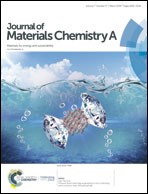Defect-rich and ultrathin CoOOH nanolayers as highly efficient oxygen evolution catalysts for photoelectrochemical water splitting†
Abstract
Herein, we have demonstrated that the plasma-exfoliation of CoOOH nanolayers (∼8 nm) into an ultrathin structure (∼2 nm) could significantly improve the PEC activities of BiVO4 photoanodes. A photocurrent density of 4.9 mA cm−2 and a charge separation efficiency of 89% have been achieved at 1.23 VRHE under AM 1.5G illumination, which are more than two-fold higher than those of pristine CoOOH/BiVO4 photoanodes.



 Please wait while we load your content...
Please wait while we load your content...